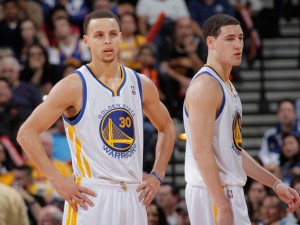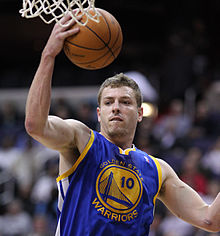
 The Golden State Warriors have started the season by winning five of their first seven games and have established themselves as legitimate title contenders. The main catalysts behind the hot start are exactly who you would have thought: Stephen Curry and Klay Thompson. But in years past, discussion around the Warriors would start and end with Curry as he was the primary catalyst under Mark Jackson. Now with Steve Kerr in as replacement and his new offense in place, Thompson has emerged as one of the premier offensive players in the league and much more than just a complementary piece.
The Golden State Warriors have started the season by winning five of their first seven games and have established themselves as legitimate title contenders. The main catalysts behind the hot start are exactly who you would have thought: Stephen Curry and Klay Thompson. But in years past, discussion around the Warriors would start and end with Curry as he was the primary catalyst under Mark Jackson. Now with Steve Kerr in as replacement and his new offense in place, Thompson has emerged as one of the premier offensive players in the league and much more than just a complementary piece.
The “Splash Brothers” really hit their stride together over the last two seasons, especially from long range. Curry led the league in threes made over the past two seasons, including the single-season record of 272 two years ago, while Thompson finished third and second in 2012-2013 and 2013-2014, respectively.
After taking a much closer look, here are two notes that put the duo’s shooting statistics in context:
- The pair’s 488 threes in the 12-13 season were more than five teams made for the entire season. Their 484 threes last year topped the Memphis Grizzlies by 79 and were just two behind the New Orleans Pelicans.
- Portland’s dynamic backcourt of Damian Lillard and Wesley Matthews both finished in the top five in three pointers made last season, but you have to go all the way back to the 01-02 season to find an instance where two teammates led the league in total number of three-point field goals made. Antoine Walker and Paul Pierce made 222 and 210 threes, respectively, for the Boston Celtics.
That Boston team, quarterbacked by Kenny Anderson, was a real contender, finishing just two wins shy of a trip to the NBA Finals. They lost to the then New Jersey Nets 4-2, proving that a team built around two dynamic and prolific three-point shooters can be a serious contender.
It’s easy to get wrapped up in the preposterous three-point numbers that these players are putting up and it’s even easier to forget how much both players’ overall games are evolving. That’s especially the case for Thompson, who became the first player to make 500 threes in his first three seasons last year. But a closer look at Thompson reveals how much more he is than just a prolific long-range shooter.
For the young season, Thompson is off to a career-best start across the board. After averaging 18.4 points a contest last year, he’s putting up 24.7 PPG through six games and shooting better than he has his entire career (48% FG, 47.4% 3FG). I believe one thing has worked in his favor thus far: Golden State’s usual starting power forward, David Lee, started the season on the injured list. A hamstring injury caused Lee to miss the first three games before returning. However, after just seven minutes he re-aggravated the injury and will miss at least a couple weeks.
 Lee averaged 18 points a game last season and is a player that needs a lot of touches. His replacement Draymond Green isn’t the same scoring threat, but can do most of the things Lee does including facilitate. As a result, more of the offense has flowed organically through Thompson, who has picked it up without much stress. New head coach Steve Kerr’s offense, which is predicated on ball movement and off-ball action, created a paradigm shift in the Warriors game-planning. The numbers show Thompson has benefitted immediately.
Lee averaged 18 points a game last season and is a player that needs a lot of touches. His replacement Draymond Green isn’t the same scoring threat, but can do most of the things Lee does including facilitate. As a result, more of the offense has flowed organically through Thompson, who has picked it up without much stress. New head coach Steve Kerr’s offense, which is predicated on ball movement and off-ball action, created a paradigm shift in the Warriors game-planning. The numbers show Thompson has benefitted immediately.
When you look at Thompson’s development, not only has he improved his ability to get more shots around the basket, but he’s making them more consistently. In the 12-13 season, Thompson attempted 28% of his field goals from less than from the basket. He made a combined 45% of those looks but shot poorly from the 5- range (28.3%) and 10- range (32.7%).
Last year Thompson took 36% of his total shots from less than away and increased his overall percentage to 48%. He shot much better in those trouble areas, too, improving to 41.3% from 5- and 38% from 10-. This season, the sample sizes are still small, but he’s already shooting at a 56% clip from less than from the basket. Thompson has great size for a shooting guard at 6’7”, and he is definitely making a more concerted effort to get closer to the rim. Not only is he getting more looks there, but he’s making them count.
Let’s take this a step further to really show how much more diverse Thompson’s game is under Kerr than Jackson. Last year, Thompson led the league in points off catch-and-shoot jump shots (9.2 a game). Catch-and-shoot, as defined by NBA tickets, is “any jump shot outside of where a player possessed the ball for 2 seconds or less and took no dribbles.” Thompson took 7.6 catch-and-shoot jump shots per game, and 5.5 of them were three pointers, second to only to Pelicans forward Ryan Anderson.
This season? Through six games, Thompson is scoring 7.2 points per game on catch-and-shoot jump shots on just 6.2 attempts per game (and only 5 three attempts a game). So where are his extra looks going? To drives (5.2 drives per game up from 2.8 last season) and pull-up jump shots (4.5 per game up from 3.9). The points he’s producing from those attempts are increasing as well: 4.5 PPG on drives (up from 2.8 last season) and 4.5 PPG on pull-ups (up from 3.3 last season). Those are substantial bumps, especially the drives. Thompson was far more one-dimensional with Jackson as coach, and Kerr is giving him more freedom within the new offense to produce all over the court.
Another drastic improvement in Klay’s game has been his ability to get to the free throw line which is directly related to Thompson’s improved drive numbers. Over the last two seasons, Thompson has only averaged 1.9 and 2.3 free throw attempts per game, respectively. Through six games played. Thompson is already averaging 6.5 free throws per game. He’s also cashing in, making 87% of those free throws. That’s an additional four points on his scoring average that wasn’t there last season, which is making him more multidimensional and complete as a scorer.
But it’s more than just four additional points for Thompson. Each additional foul he draws stops the clock, thus creating more possessions. Each foul not only gets his team closer to the bonus, they create more potential scoring opportunities especially late in games because more fouls force opposing deeper into their benches. All of these things help turn the Warriors into a much better half court team, which often is a deciding factor in the playoffs.
The best evidence of Thompson’s more well-rounded game comes from his 41-point outburst in the Warriors’ home opener against the Los Angeles Lakers tickets. Thompson picked up two quick fouls in the game but was still able to heat up and make plays all over the court. The stat line speaks for itself:
41 points on 14-18 shooting (5-7 from three, 8-9 on free throws), five rebounds, two assists and just one turnover.
Thompson had plenty of expectations going into the season. Reportedly, the Warriors could have traded for Kevin Love, but refused to include Thompson in the deal. The Warriors refusal to include Thompson in the deal was widely questioned and criticized by pundits around the country. As the second option on a team that won 51 games a season ago, Thompson was supposed to elevate his game. The Warriors doubled down on that expectation by giving Thompson the max extension one game into the season. So far he’s proven the Warriors right. At just 24, he is showing he is one of the elite shooting guards in the league, and fans can see him tonight for $16 when the Warriors and Nets play in Golden State.
The bottom line is if Thompson continues to play at such a high, all-around level, the Warriors will supplant themselves as serious contenders to bring another championship back to the Bay Area for the first time since 1975.